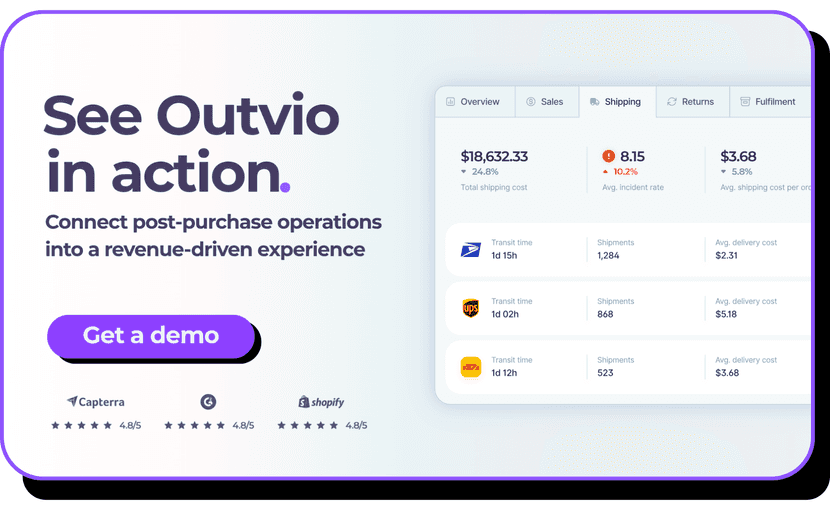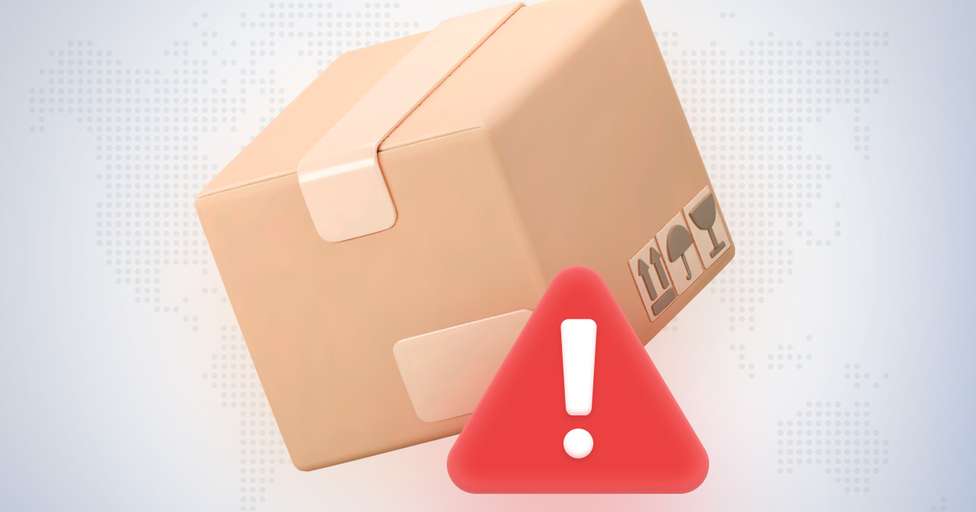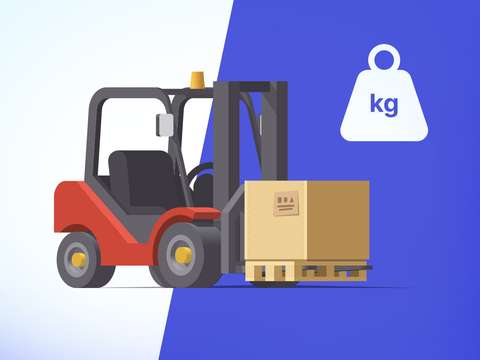Surely, you’ve seen the alert "Your package has a delivery exception" from USPS, FedEx, or DHL more than once.
The delivery process is crucial to maintaining a strong relationship between a store and its customers. Unexpected delivery exceptions—such as shipment delays, status updates, or customs clearance holds—can create frustration and uncertainty.
Providing great service goes beyond simply avoiding failed delivery attempts. It’s essential to understand what each tracking status means, from "order not due for delivery" to "package held by carrier," and know how to respond effectively.
In this guide, we’ll break down common delivery exceptions, their causes, and how to handle them.

What is a delivery exception?
A delivery exception is a tracking status that indicates a shipment has deviated from its expected transit route or delivery timeline. Issued by carriers like UPS, FedEx, DHL, or USPS, it serves as an alert within the shipping process, notifying both retailers and recipients of an irregularity.
If a package displays a delivery status alert, it doesn’t always mean it will arrive late. Thanks to modern tracking systems, customers can receive real-time notifications to update their shipping details, schedule a redelivery attempt, or resolve any pending issue affecting their parcel’s transit.
How do shipping package exceptions affect retailers?
A shipment exception isn’t just a logistics issue—it’s a business risk. Every delayed, lost, or misrouted package leads to frustrated customers, refund claims, and potential churn.
One major consequence? WISMO (Where Is My Order?) inquiries. According to Forbes, nearly 60% of customer service requests in eCommerce are delivery-related. Without automated tracking updates, support teams waste time answering repetitive questions instead of solving critical issues.
But the impact goes beyond customer support overload. A Wall Street Journal report found that 70% of shoppers are less likely to buy again after a bad delivery experience. Another study from Consumer Reports highlights that 67% of negative reviews mention shipping problems, including failed delivery attempts, customs holds, and unexpected delays.
Another problem that a shipping or delivery exception can cause:
- Leads to more refunds and chargebacks, cutting into revenue
- Breaks customer trust, making shoppers less likely to order again
- Hurts brand reputation, generating negative reviews and social media complaints
- Slows down operations, requiring extra resources for reshipments and issue resolution.
- Disrupts inventory management, making it harder to track stock and plan orders
- Increases return rates, as customers reject late deliveries or reorder before the first package arrives
9 Most common shipment exceptions and the status updates
1. Incorrect or incomplete address
If the shipping address is missing details like a street number, zip code, or apartment number, your package has an exception and might be returned to sender. This type of exception in delivery is common when customers enter an incorrect address or auto-fill gets it wrong.
If you see an update like "delivery of package failed due to some shipping exception", contact the carrier (DHL, FedEx, UPS, USPS) immediately to correct the details.
2. Severe weather conditions
Extreme weather—like snowstorms, hurricanes, or heavy rain—can cause a shipping exception because the carrier may be unable to deliver. When this happens, your tracking might show "delivery exception future delivery requested" or "status exception – weather delay".
3. Customs clearance issues (for international shipments)
If your package is stuck in customs, it could be due to missing paperwork, unpaid duties, or restricted items. A shipment exception FedEx meaning customs hold might appear in your tracking, or you may see "what does DHL exception mean?" if you’re using their services. To avoid this, ensure your international shipment complies with the regulations of the destination country.
4. Damaged or lost package
If a package has an exception due to damage, the carrier may halt the delivery until they assess the condition. Tracking updates like "shipment exception meaning lost or damaged" or "package delayed due to some unforeseen reasons" indicate this issue.
5. Delivery attempt failed
A failed attempt can happen for several reasons: the recipient wasn't available, access to the location was restricted, or even "delivery exception animal interference" (yes, aggressive pets can delay your shipment!). To prevent further delays, it's a good idea to offer customers the option to pick up their package at a designated pickup point.
6. Label or barcode issues
If the shipping label is unreadable, torn, or missing, the carrier won’t be able to scan it properly, which can result in a shipment exception due to a damaged or missing label.
This often triggers a status exception update, such as "exception handling – relabeled", meaning the carrier has attempted to fix the issue. In some cases, this is resolved automatically, but if the package remains stuck, the seller may need to step in by providing a new label or verifying the shipment details with the carrier to prevent further delays.
7. High package volume during peak seasons
During busy periods like Black Friday, Christmas, or major sales events, carriers handle an overwhelming number of shipments, increasing the risk of delivery exceptions due to high volume.
When too many packages enter the system at once, delays in processing and sorting can occur, triggering updates like "shipment exception peak season delay" or "your order has a delivery exception due to high demand".
8. Mechanical or transportation issues
Unexpected transportation failures—such as a sorting facility shutdown, vehicle breakdowns, or canceled flights—can result in shipment exceptions that delay delivery. This typically appears as a "transit delay exception" or "exception shipping status awaiting transport" in tracking updates.
9. Security delays or restricted locations
Shipments going to government buildings, military bases, and restricted areas often require additional verification, leading to security-related delivery exceptions. If a package is flagged with an update like "recipient location security delay – delivery will be reattempted", it usually means the carrier is reviewing the shipment before proceeding.
How to reduce, prevent, and handle package exceptions
1. Verify all shipping details before sending
One of the biggest reasons for a package exception is an incorrect or incomplete address. Before sending out an order, ensure that:
- The recipient's address is 100% correct, including unit numbers, ZIP codes, and business names when needed
- The shipping method matches the destination, avoiding a shipment exception due to misrouting
- Any special delivery instructions, like gate codes or specific drop-off points, are clearly included
Using automated shipping software with address verification system can catch common errors before they result in a delivery exception requiring correction.
2. Ensure all shipping documents are included
Even if the package is picked up, missing minor paperwork can cause a package exception later in the process, requiring additional action before the delivery can proceed.
Before dispatching, confirm that the package has:
- A commercial invoice for customs clearance.
- The correct customs codes or HS tariff classifications to avoid a shipment exception clearance delay.
- A properly filled shipping label to prevent delays
3. Use the right packaging to avoid damage
Better packaging reduces the chance of a shipment exception due to product damage, minimizing the risk of reshipments or refunds.
To reduce the risk:
- Use sturdy boxes and cushioning materials for fragile items
- Avoid paper labels in wet or humid conditions, as they can smudge or tear, causing an exception shipping status unreadable label
- Ensure labels aren’t covered by tape or placed on a curved surface, which can lead to a shipment exception due to scanning issues
With Outvio's packaging software, every order is shipped with the correct packaging, ensuring better protection and compliance with carrier requirements
4. Properly place and secure shipping labels
If the tracking status shows an exception handling relabeled, it likely means the carrier had to fix or reprint the label, adding delays to the delivery.
To prevent this:
- Attach the shipping label on a flat, visible surface
- Ensure it’s not bent, folded, or obscured by tape
- If shipping internationally, double-check that all required customs information is visible
5. Keep customers informed about their shipment
Keeping customers informed reduces complaints and builds trust. Best practices include:
- Automated tracking updates via email or SMS or Whatsapp
- Clear explanations when a package has an exception causing transit delays
- Easy access to customer support to resolve concerns
Since shipping tracking emails have high open rates, they’re a great way to keep buyers engaged while also reducing inbound support tickets.
6. Optimize warehouse and fulfillment processes
Errors in warehouse operations can lead to shipment exceptions before the package even leaves the facility. Common issues include incorrect item selection, wrong packaging, or delays in processing. To minimize risks:
- Implement a picking and packing system to prevent errors
- Ensure warehouse staff follows a standardized shipping process
- Use real-time tracking systems to monitor package movements internally before handoff to the carrier
By improving warehouse efficiency, sellers can significantly reduce cases where an order is flagged with a shipment exception status update due to internal mistakes.
7. Choose reliable shipping partners and service
Carefully choosing shipping partners helps minimize exception shipping status issues and improves overall delivery reliability.
- Work with trusted logistics providers that have a track record of low exception rates
- Select the right service level—express shipping options often have lower risk of exceptions than economy shipping.
- Consider insuring high-value packages to ensure faster resolution in case of a lost or damaged shipment.
Working with multiple carriers allows you to choose the most suitable option based on conditions and switch to another if issues arise, ensuring fewer exception shipping status problems and greater delivery reliability.
What if my delivery exception takes too long?
When a shipment exception remains unresolved for several days, it’s essential to act quickly.
The first step is to monitor tracking updates. If the delay persists, contacting the carrier is necessary to determine the cause. If the issue is related to missing documents, an unreadable label, or a failed delivery attempt, providing additional information may be required.
For exceptions caused by weather disruptions or peak season congestion, delays are unavoidable, but keeping customers informed can help manage expectations.
If the package remains stuck beyond the expected timeframe, rerouting it to a nearby facility or arranging a pickup could be an option. If the shipment is lost, filing a claim is the next step to recover costs.
Looking ahead, automated logistics and AI-driven exception handling will make it easier to prevent long delays by identifying and resolving issues in real time.
Until then, ensuring that shipping details are correct, labels are properly placed, and all necessary documents are included remains the best strategy to minimize delivery exceptions.
Want to take full control of your deliveries? Request a demo today and see how Outvio can optimize your shipping process!
Order exception: Table summary for delivery in 2025
| Cause | Common Status Updates | How to Reduce the Risk |
|---|---|---|
| Incorrect or incomplete address | - FedEx: "delivery exception incorrect address" - UPS: "the street number is incorrect" - USPS: "delivery exception forwarding requested" - DHL: "exception: address information needed" | Verify addresses before shipping using an order validation tool. Double-check unit numbers, ZIP codes, and business names. |
| Severe weather conditions | - FedEx: "delivery exception weather delay" - UPS: "exception – severe weather conditions" - USPS: "shipment exception due to weather" - DHL: "status exception: weather conditions" | Adjust estimated delivery times during bad weather and notify customers in advance. |
| Customs clearance issues | - FedEx: "shipment exception customs hold" - UPS: "exception: clearance in progress" - USPS: "customs clearance delay" - DHL: "exception: regulatory clearance delay" | Ensure all customs paperwork is complete, including invoices and tariff codes, to avoid clearance delays. |
| Damaged or lost package | - FedEx: "shipment exception damaged in transit" - UPS: "package damaged – investigation in progress" - USPS: "package delayed due to some unforeseen reasons" - DHL: "exception: package damage reported" | Use sturdy packaging and Outvio’s packaging software to ensure proper materials for each order. |
| Delivery attempt failed | - FedEx: "delivery exception animal interference" - UPS: "delivery attempt failed – access issue" - USPS: "unable to deliver – no access" - DHL: "exception: delivery attempt unsuccessful" | Provide clear delivery instructions and allow customers to update preferences when necessary. |
| Label or barcode issues | - FedEx: "exception handling – relabeled" - UPS: "unable to process – barcode unreadable" - USPS: "shipment exception label damaged" - DHL: "exception: missing or incorrect label" | Use high-quality labels and place them on flat, visible surfaces. Avoid covering them with tape. |
| High package volume delays | - FedEx: "delivery exception due to high volume" - UPS: "shipment delayed due to peak season" - USPS: "shipment exception – high package volume" - DHL: "exception: processing delay due to high demand" | Plan ahead for peak seasons and adjust delivery estimates to manage customer expectations. |
| Mechanical or transportation issues | - FedEx: "shipment exception transit delay" - UPS: "transportation delay – mechanical failure" - USPS: "exception shipping status awaiting transport" - DHL: "status exception: transportation issue" | Communicate delays to customers and consider alternative carriers if disruptions persist. |
| Security delays or restricted locations | - FedEx: "recipient location security delay. delivery will be reattempted" - UPS: "delivery exception – restricted area" - USPS: "shipment exception security hold" - DHL: "exception: additional verification required" | Confirm address eligibility for restricted areas and ensure all required documentation is included. |
Conclusions
Avoiding unnecessary delivery exceptions should be one of the priorities of any eCommerce business invested in creating the best purchasing experience. However, as you've seen, completely eliminating them is impossible.
For this reason, being familiar with the most common types of exceptions and how you should handle them is extremely important. It will help you reduce the harm exceptions can bring to your business, and you’ll be able to use these situations as an opportunity to improve the customer service you provide, instead of letting customers use it as an excuse to never come back to your online store.
Implement our general tips to reduce exceptions as much as possible and try to make the most out of every single exception to show customers that you care.




